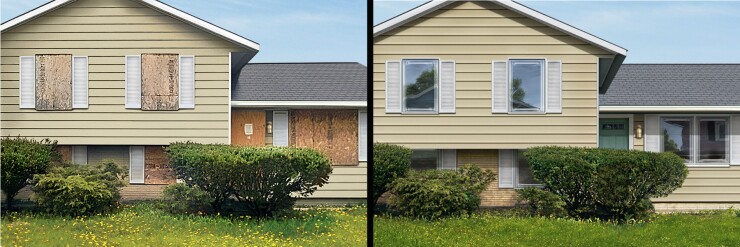The days of vacant, distressed homes covered in sheets of plywood appear numbered, as Fannie Mae and Freddie Mac move toward greater adoption of polycarbonate "clear boarding" to secure preforeclosure and real estate owned properties.
Fannie Mae began mandating clear boarding on preforeclosure properties last month, extending a policy enacted in November allowing the practice. The government-sponsored enterprise has required clear boarding on REO properties since 2014.
Meanwhile, Freddie Mac also issued new guidelines in April allowing servicers to use clear boarding on preforeclosure properties, "where needed and as required by local ordinances."
"Clear boarding, which gives the appearance of a traditional window, is more aesthetically pleasing and supports neighborhood stabilization. In addition, it is more durable than plywood and provides better security," Jacob Williamson, a Fannie Mae vice president who oversees distressed properties, said in an emailed response to questions.
The policy shifts come as rising home prices and fewer mortgage defaults have drastically cut REO inventories. Fannie Mae had less than 35,000 REO properties at the end of the first quarter of 2017, down nearly 80% from the crisis peak in the third quarter of 2010. Freddie Mac had less than 11,000 properties at the end of the first quarter, down 85% from the peak.

While the foreclosure crisis brought about myriad technology improvements and other enhancements to how servicers and their vendors manage distressed and REO properties, not much has changed in the way preservation companies secure windows and doors on these homes.
But vacant properties boarded with plywood have historically been associated with community blight and increased neighborhood crime. The large wooden boards are an obvious alert to passers-by that the property is vacant, which tends to attract the wrong kind of attention.
"The moment you put up a plywood board, you actually designate that particular house and the surrounding houses as vacant and abandoned," said Robert Klein, chairman and co-founder of Cleveland-based Community Blight Solutions, which sells clear boarding through its Secureview division. Klein is also the chairman and founder of property preservation vendor Safeguard Properties.
Fannie and Freddie have specifications for clear boarding materials, but do not require use of a specific vendor's product. However, Fannie Mae's recent bulletin names both SecureView and InvisiBoard, a clear boarding product sold by Tampa, Fla.-based property preservation vendor Cyprexx Services.

The move toward clear boarding comes as some local and state governments have outlawed the use of plywood on vacant properties, including Ohio, which became the first to enact a statewide ban on plywood last month. Community Blight Solutions lobbied on behalf of the law, known as House Bill 463, according to Ohio lobbying records.
"Our goal is to get houses back on the market as fast as possible before they become blighted properties… that are unattractive to buyers," said Adam Hewitt, a lobbyist who represents Community Blight Solutions and the Ohio Mortgage Bankers Association, among other clients. "We are creating a housing market that is affordable to a lot of families that wouldn't normally be able to afford it."
When clear boarding is installed, it's more difficult for passers-by to tell if a property is occupied or vacant. And the plastic sheets are stronger than plywood, making break-ins less likely.
But that extra durability doesn't come cheap, as the cost of installing clear boarding runs about 70% higher than plywood, according to estimates in a study commissioned by Community Blight Solutions.
Still, clear boarding proponents argue the higher upfront costs are more than offset by higher home values and lower maintenance and security costs for servicers and municipal governments.
"While clear boarding is initially more expensive than plywood, we believe the higher up-front cost is reduced over time by the durability of clear boarding," said Williamson. "Unlike plywood, clear boarding does not deteriorate and need to be periodically replaced."




